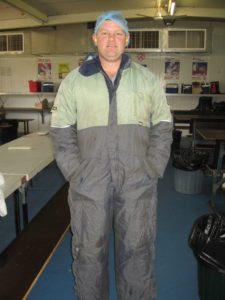Eliminating or reducing hazards associated with extremes of temperature
What effects may occur from exposure to extremes of temperature?
Workers in meat processing plants are frequently exposed to cold temperatures. Work is carried out in cold temperatures in areas including boning rooms, despatch areas, chillers, freezers and sometimes outdoors.
The body reacts to exposure to cold by trying to maintain its temperature by constricting blood flow to the skin. The skin changes, shivering and postural changes may lead to a loss of coordination and feeling. This is turn may increase the risk of accidents and soft tissue damage. Similarly, cold may aggravate the effects of other workplace hazards.
Exposure to cold may result in hypothermia, where the body’s core temperature may drop to a dangerous level. Frostbite is another risk in cold areas.
Exposure to high temperature and excessive humidity may also occur at meat processing plants in areas such as yards and pens, rendering areas and scalding and singeing areas where pigs are processed.
Exposure to high temperatures may lead to rashes, cramps, fainting, heat exhaustion and heat stroke.
How are the risks of exposure to extremes of temperature controlled?
Risks associated with working in areas where there are extremes of temperature are controlled in the same way as all other risks are managed in the work place by the implementation of a risk control program for extremes of temperature. This involves:
Identifying the hazards
Management takes a planned and systematic approach to identify all the areas and situations of extreme temperature at the site.
Assessing the risks
Once the hazards have been identified then all the factors that may contribute to the risk are identified. In extremes of temperature these may include:
- air temperature, air movement and humidity
- length of exposure
- nature and level of work
- types of clothing and footwear
- levels of fluid loss and replacement
- personal factors – for example, use of certain medications and/or pre – existing medical conditions, level of physical fitness and obesity can affect the risk of heat stress. Pregnancy can also reduce tolerance to heat.
Identifying and implementing controls
It is generally not possible to eliminate exposure to cold temperature, as it is a legal requirement for meat to be stored at low temperature to meet food safety and preservation requirements. Control measures to reduce risks to the lowest possible levels may include:
- restricted entry to cold areas for essential activities only or only by authorised persons
- wearing suitable clothing, footwear and PPE
- following work instructions, Standard Operating Procedures (SOPs) and any other workplace procedures
- undertaking training including emergency procedures
- gaining permission to enter the area
- not working alone in a freezing chamber.
Management is responsible to implement the most effective controls particularly focusing on engineering controls such as:
The indoor working environment
- ventilation and mechanical cooling methods, such as air conditioning and/or air circulating fans;
- provision of mechanisms external to the workplace to assist in temperature control, such as planting shade trees, and the use of eaves and verandahs;
- insulating the roofs and walls of the work place
- insulating or shielding sources of radiant heat in the work place, e.g.. insulation around ovens, furnaces or other sources of radiant heat; and/or insulated barriers between hotter and cooler parts of the workplace
- exhaust ducts for venting hot air from the work place. The outdoor working environment.
Arrangements for outdoor working environments should include:
- erection of shelters, tents and/or windbreaks (in the case of hot, dry winds) and provision of suitable clothing, hats etc., to protect outdoor workers from the heat and exposure to UV radiation
- provision of air-conditioned work vehicles
What is the role of workers in reducing risks in extreme temperature?
Workers are responsible for cooperating with control measures to eliminate or reduce risks. For example, workers should wear suitable clothing when entering or working in freezers and only enter when authorised and trained to do so.

Cold room clothing
Courtesy Fletcher International © MINTRAC
In heatwave conditions management will advise you of precautions that should be taken. If you feel that you are a danger to yourself or others because of the heat you should report to your supervisor. Controls to reduce risks in high temperatures include taking rest and fluid breaks.
